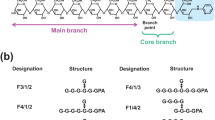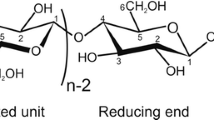Abstract
Capsule of Escherichia coli O5:K4:H4 is formed of a chondroitin-repeat disaccharide unit of glucuronic acid (GlcA)-N-acetylgalactosamine (GalNAc). This polysaccharide, commonly referred to as K4CP, is a potentially important source of precursors for chemoenzymatic or bioengineering synthesis of chondroitin sulfate. KfoA, encoded by a gene from region 2 of the K4 capsular gene cluster, shows high homology to the UDP-glucose-4-epimerase (GalE) from E. coli. KfoA is reputed to be responsible for uridine 5′-diphosphate-N-acetylgalactosamine (UDP-GalNAc) supply for K4CP biosynthesis in vivo, but it has not been biochemically characterized. Here, we probed the substrate specificity of KfoA by a capillary electrophoresis (CE)-based method. KfoA could epimerize both acetylated and non-acetylated substrates, but its k cat/K m value for UDP-GlcNAc was approximately 1300-fold that for UDP-Glc. Recombinant KfoA showed a strong preference for acetylated substrates in vitro. The conclusion that KfoA is a higher efficiency UDP-GalNAc provider than GalE was supported by a coupled assay developed based on the donor-acceptor combination specificity of E. coli K4 chondroitin polymerase (KfoC). Furthermore, residue Ser-301, located near the UDP-GlcNAc binding pocket, plays an important role in the determination of the conversion ratio of UDP-GlcNAc to UDP-GalNAc by KfoA. Our results deepen the understanding of the mechanism of KfoA and will assist in the research into the metabolic engineering for chondroitin sulfate production.






Similar content being viewed by others
References
Beerens K, Soetaert W, Desmet T (2015) UDP-hexose 4-epimerases: a view on structure, mechanism and substrate specificity. Carbohydr Res 414:8–14. https://doi.org/10.1016/j.carres.2015.06.006
Bhaskar U, Sterner E, Hickey AM, Onishi A, Zhang F, Dordick JS, Linhardt RJ (2012) Engineering of routes to heparin and related polysaccharides. Appl Microbiol Biotechnol 93(1):1–16. https://doi.org/10.1007/s00253-011-3641-4
Bhatt VS, Guan W, Xue M, Yuan H, Wang PG (2011) Insights into role of the hydrogen bond networks in substrate recognition by UDP-GalNAc 4-epimerases. Biochem Biophys Res Commun 412(2):232–237. https://doi.org/10.1016/j.bbrc.2011.07.071
Chen X, Kowal P, Hamad S, Fan H, Wang PG (1999) Cloning, expression and characterization of a UDP-galactose 4-epimerase from Escherichia coli. Biotechnol Lett 21(12):1131–1135. https://doi.org/10.1023/A:1005678225031
Cimini D, Iacono ID, Carlino E, Finamore R, Restaino OF, Diana P, Bedini E, Schiraldi C (2017) Engineering S. equi subsp. zooepidemicus towards concurrent production of hyaluronic acid and chondroitin biopolymers of biomedical interest. AMB Express 7(1):61. https://doi.org/10.1186/s13568-017-0364-7
Cress BF, Greene ZR, Linhardt RJ, Koffas MAG (2013a) Draft genome sequence of Escherichia coli strain ATCC 23502 (Serovar O5:K4:H4). Genome Announc 1(2):e00046–e00013. https://doi.org/10.1128/genomeA.00046-13
Cress BF, Greene ZR, Linhardt RJ, Koffas MAG (2013b) Draft genome sequence of Escherichia coli strain ATCC 23506 (Serovar O10:K5:H4). Genome Announc 1(2):e00049–e00013. https://doi.org/10.1128/genomeA.00049-13
Creuzenet C, Belanger M, Wakarchuk WW, Lam JS (2000) Expression, purification, and biochemical characterization of WbpP, a new UDP-GlcNAc C4 epimerase from Pseudomonas aeruginosa serotype O6. J Biol Chem 275(25):19060–19067. https://doi.org/10.1074/jbc.M001171200
DeAngelis PL, Liu J, Linhardt RJ (2013) Chemoenzymatic synthesis of glycosaminoglycans: re-creating, re-modeling and re-designing nature’s longest or most complex carbohydrate chains. Glycobiology 23(7):764–777. https://doi.org/10.1093/glycob/cwt016
DeAngelis PL, White CL (2002) Identification and molecular cloning of a heparosan synthase from Pasteurella multocida type D. J Biol Chem 277(9):7209–7213. https://doi.org/10.1074/jbc.M112130200
Esko JD, Kimata K, Lindahl U (2009) Proteoglycans and sulfated glycosaminoglycans. In: Varki A, Cummings RD, Esko JD, Freeze HH, Stanley P, Bertozzi CR, Hart GW, Etzler ME (eds) Essentials of Glycobiology, 2nd edn. Cold Spring Harbor Laboratory Press, Cold Spring Harbor (NY)
Fu L, Suflita M, Linhardt RJ (2016) Bioengineered heparins and heparan sulfates. Adv Drug Deliv Rev 97:237–249. https://doi.org/10.1016/j.addr.2015.11.002
Gibson DG, Young L, Chuang R-Y, Venter JC, Hutchison CA, Smith HO (2009) Enzymatic assembly of DNA molecules up to several hundred kilobases. Nat Methods 6(5):343–345. https://doi.org/10.1038/nmeth.1318
Green DE, DeAngelis PL (2017) Identification of a chondroitin synthase from an unexpected source, the green sulfur bacterium Chlorobium phaeobacteroides. Glycobiology 27(5):469–476. https://doi.org/10.1093/glycob/cwx008
Griffiths G, Cook NJ, Gottfridson E, Lind T, Lidholt K, Roberts IS (1998) Characterization of the glycosyltransferase enzyme from the Escherichia coli K5 capsule gene cluster and identification and characterization of the glucuronyl active site. J Biol Chem 273(19):11752–11757. https://doi.org/10.1074/jbc.273.19.11752
Guirguis N, Schneerson R, Bax A, Egan W, Robbins JB, Shiloach J, Orskov I, Orskov F, el Kholy A (1985) Escherichia coli K51 and K93 capsular polysaccharides are crossreactive with the group a capsular polysaccharide of Neisseria meningitidis. Immunochemical, biological, and epidemiological studies. J Exp Med 162(6):1837–1851. https://doi.org/10.1084/jem.162.6.1837
Guo H, Li L, Wang PG (2006) Biochemical characterization of UDP-GlcNAc/Glc 4-epimerase from Escherichia coli O86:B7. Biochemistry (Mosc) 45(46):13760–13768. https://doi.org/10.1021/bi0612770
Handel TM, Johnson Z, Crown SE, Lau EK, Proudfoot AE (2005) Regulation of protein function by glycosaminoglycans-as exemplified by chemokines. Annu Rev Biochem 74(1):385–410. https://doi.org/10.1146/annurev.biochem.72.121801.161747
He W, Fu L, Li G, Andrew Jones J, Linhardt RJ, Koffas M (2015) Production of chondroitin in metabolically engineered E. coli. Metab Eng 27:92–100. https://doi.org/10.1016/j.ymben.2014.11.003
He W, Zhu Y, Shirke A, Sun X, Liu J, Gross RA, Koffas MAG, Linhardt RJ, Li M (2017) Expression of chondroitin-4-O-sulfotransferase in Escherichia coli and Pichia pastoris. Appl Microbiol Biotechnol 101(18):1–10. https://doi.org/10.1007/s00253-017-8411-5
Holden HM, Rayment I, Thoden JB (2003) Structure and function of enzymes of the Leloir pathway for galactose metabolism. J Biol Chem 278(45):43885–43888. https://doi.org/10.1074/jbc.R300025200
Ishiyama N, Creuzenet C, Lam JS, Berghuis AM (2004) Crystal structure of WbpP, a genuine UDP-N-acetylglucosamine 4-epimerase from Pseudomonas aeruginosa SUBSTRATE SPECIFICITY IN UDP-HEXOSE 4-EPIMERASES. J Biol Chem 279(21):22635–22642. https://doi.org/10.1074/jbc.M401642200
Jin P, Zhang L, Yuan P, Kang Z, Du G, Chen J (2016) Efficient biosynthesis of polysaccharides chondroitin and heparosan by metabolically engineered Bacillus subtilis. Carbohydr Polym 140:424–432. https://doi.org/10.1016/j.carbpol.2015.12.065
Kavanagh KL, Jörnvall H, Persson B, Oppermann U (2008) Medium- and short-chain dehydrogenase/reductase gene and protein families. Cell Mol Life Sci 65(24):3895–3906. https://doi.org/10.1007/s00018-008-8588-y
Kowal P, Wang PG (2002) New UDP-GlcNAc C4 epimerase involved in the biosynthesis of 2-acetamino-2-deoxy-L-altruronic acid in the O-antigen repeating units of Plesiomonas shigelloides O17. Biochemistry 41(51):15410–15414. https://doi.org/10.1021/bi026384i
Li Y, Huang X, Harmonay L, Liu Y, Kellogg MD, Fridovich-Keil JL, Berry GT (2014) Liquid chromatography–tandem mass spectrometry enzyme assay for UDP-galactose 4′-epimerase: use of fragment intensity ratio in differentiation of structural isomers. Clin Chem 60(5):783–790. https://doi.org/10.1373/clinchem.2013.219931
Liu J, Linhardt RJ (2014) Chemoenzymatic synthesis of heparan sulfate and heparin. Nat Prod Rep 31(12):1676–1685. https://doi.org/10.1039/C4NP00076E
Liu J, Pedersen LC (2006) Anticoagulant heparan sulfate: structural specificity and biosynthesis. Appl Microbiol Biotechnol 74(2):263–272. https://doi.org/10.1007/s00253-006-0722-x
Liu J, Yang A, Liu J, Ding X, Liu L, Shi Z (2014) KfoE encodes a fructosyltransferase involved in capsular polysaccharide biosynthesis in Escherichia coli K4. Biotechnol Lett 36(7):1469–1477. https://doi.org/10.1007/s10529-014-1502-9
Liu Y, Thoden JB, Kim J, Berger E, Gulick AM, Ruzicka FJ, Holden HM, Frey PA (1997) Mechanistic roles of tyrosine 149 and serine 124 in UDP-galactose 4-epimerase from Escherichia coli. Biochemistry 36(35):10675–10684. https://doi.org/10.1021/bi970430a
Monslow J, Govindaraju P, Puré E (2015) Hyaluronan-a functional and structural sweet spot in the tissue microenvironment. Front Immunol 6:231. https://doi.org/10.3389/fimmu.2015.00231
Ninomiya T, Sugiura N, Tawada A, Sugimoto K, Watanabe H, Kimata K (2002) Molecular cloning and characterization of chondroitin polymerase from Escherichia coli strain K4. J Biol Chem 277(24):21567–21575. https://doi.org/10.1074/jbc.M201719200
Rimler RB, Rhoades KR (1987) Serogroup F, a new capsule serogroup of Pasteurella multocida. J Clin Microbiol 25(4):615–618
Rodriguez M-L, Jann B, Jann K (1988) Structure and serological characteristics of the capsular K4 antigen of Escherichia coli O5:K4:H4, a fructose-containing polysaccharide with a chondroitin backbone. Eur J Biochem 177(1):117–124. https://doi.org/10.1111/j.1432-1033.1988.tb14351.x-i2
Sasisekharan R, Raman R, Prabhakar V (2006) Glycomics approach to structure-function relationships of glycosaminoglycans. Annu Rev Biomed Eng 8(1):181–231. https://doi.org/10.1146/annurev.bioeng.8.061505.095745
Shimmura S, Ono M, Shinozaki K, Toda I, Takamura E, Mashima Y, Tsubota K (1995) Sodium hyaluronate eyedrops in the treatment of dry eyes. Br J Ophthalmol 79(11):1007–1011. https://doi.org/10.1136/bjo.79.11.1007
Suflita M, Fu L, He W, Koffas M, Linhardt RJ (2015) Heparin and related polysaccharides: synthesis using recombinant enzymes and metabolic engineering. Appl Microbiol Biotechnol 99(18):7465–7479. https://doi.org/10.1007/s00253-015-6821-9
Thoden JB, Henderson JM, Fridovich-Keil JL, Holden HM (2002) Structural analysis of the Y299C mutant of Escherichia coli UDP-galactose 4-epimerase. Teaching an old dog new tricks J Biol Chem 277(30):27528–27534. https://doi.org/10.1074/jbc.M204413200
Thoden JB, Wohlers TM, Fridovich-Keil JL, Holden HM (2001) Human UDP-galactose 4-epimerase. Accommodation of udp-n-acetylglucosamine within the active site J Biol Chem 276(18):15131–15136. https://doi.org/10.1074/jbc.M100220200
Thompson JD, Higgins DG, Gibson TJ (1994) CLUSTAL W: improving the sensitivity of progressive multiple sequence alignment through sequence weighting, position-specific gap penalties and weight matrix choice. Nucleic Acids Res 22(22):4673–4680. https://doi.org/10.1093/nar/22.22.4673
Uebelhart D (2008) Clinical review of chondroitin sulfate in osteoarthritis. Osteoarthritis cartilage 16. Supplement 3:S19–S21. https://doi.org/10.1016/j.joca.2008.06.006
Vaidyanathan D, Williams A, Dordick JS, Koffas MAG, Linhardt RJ (2017) Engineered heparins as new anticoagulant drugs. Bioeng Transl Med 2(1):17–30. https://doi.org/10.1002/btm2.10042
Vann WF, Schmidt MA, Jann B, Jann K (1981) The structure of the capsular polysaccharide (K5 antigen) of urinary-tract-infective Escherichia coli 010:K5:H4. A polymer similar to desulfo-heparin. Eur J Biochem 116(2):359–364. https://doi.org/10.1111/j.1432-1033.1981.tb05343.x
Wang Z, Dordick JS, Linhardt RJ (2011) Escherichia coli K5 heparosan fermentation and improvement by genetic engineering. Bioeng Bugs 2(1):63–67. https://doi.org/10.4161/bbug.2.1.14201
Whitfield C (2006) Biosynthesis and assembly of capsular polysaccharides in Escherichia coli. Annu Rev Biochem 75(1):39–68. https://doi.org/10.1146/annurev.biochem.75.103004.142545
Wilson DB, Hogness DS (1964) The enzymes of the galactose operon in Escherichia coli I. Purification and characterization of uridine diphosphogalactose 4-epimerase. J Biol Chem 239:2469–2482
Wu JR, Chen PY, Shien JH, Shyu CL, Shieh HK, Chang F, Chang PC (2010) Analysis of the biosynthesis genes and chemical components of the capsule of Avibacterium paragallinarum. Vet Microbiol 145(1-2):90–99. https://doi.org/10.1016/j.vetmic.2010.03.002
Xu Y, Cai C, Chandarajoti K, Hsieh PH, Li L, Pham TQ, Sparkenbaugh EM, Sheng J, Key NS, Pawlinski R, Harris EN, Linhardt RJ, Liu J (2014) Homogeneous low-molecular-weight heparins with reversible anticoagulant activity. Nat Chem Biol 10(4):248–250. https://doi.org/10.1038/nchembio.1459
Xu Y, Masuko S, Takieddin M, Xu H, Liu R, Jing J, Mousa SA, Linhardt RJ, Liu J (2011) Chemoenzymatic synthesis of homogeneous ultralow molecular weight heparins. Science 334(6055):498–501. https://doi.org/10.1126/science.1207478
Xue J, Jin L, Zhang X, Wang F, Ling P, Sheng J (2016) Impact of donor binding on polymerization catalyzed by KfoC by regulating the affinity of enzyme for acceptor. Biochim Biophys Acta-Gen Subj 1860(4):844–855. https://doi.org/10.1016/j.bbagen.2016.01.018
Yin FX, Wang FS, Sheng JZ (2016) Uncovering the catalytic direction of chondroitin AC exolyasefrom the reducing end towards the non-reducing end. J Biol Chem 291(9):4399–4406. https://doi.org/10.1074/jbc.C115.708396
Zanfardino A, Restaino OF, Notomista E, Cimini D, Schiraldi C, Rosa MD, Felice MD, Varcamonti M (2010) Isolation of an Escherichia coli K4 kfoC mutant over-producing capsular chondroitin. Microb Cell Factories 9(1):34. https://doi.org/10.1186/1475-2859-9-34
Acknowledgements
This work was supported in part by the National Natural Science Foundation of China (Project no. 31770845), as well as the Projects of the Science and Technology Department of Shandong Province (Project nos. 2015GSF121002 and 2015ZDJS04002). We gratefully thank Dr. Lan Jin for the discussion and suggestions.
Author information
Authors and Affiliations
Contributions
JS and FW designed and coordinated the work. HZ carried out the experiments. YL expressed the KfoA. HZ and DM prepared the KfoA mutants. HZ and TW prepared the donors. HZ and BS conducted the docking analysis. SZ conducted the MS analysis. JS and HZ wrote the manuscript. All authors read and approved the final manuscript.
Corresponding author
Ethics declarations
Conflict of interest
The authors declare that they have no conflict of interest.
Electronic supplementary material
ESM 1
(PDF 953 kb)
Rights and permissions
About this article
Cite this article
Zhu, HM., Sun, B., Li, YJ. et al. KfoA, the UDP-glucose-4-epimerase of Escherichia coli strain O5:K4:H4, shows preference for acetylated substrates. Appl Microbiol Biotechnol 102, 751–761 (2018). https://doi.org/10.1007/s00253-017-8639-0
Received:
Revised:
Accepted:
Published:
Issue Date:
DOI: https://doi.org/10.1007/s00253-017-8639-0




